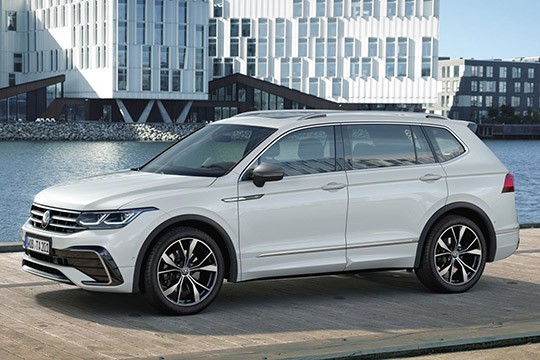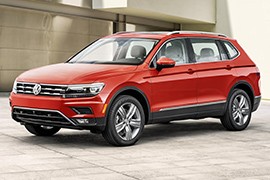VOLKSWAGEN Tiguan Allspace Models/Series Timeline, Specifications & Photos
First production year: 2017
Engines: Gasoline, Diesel
Body style: SUV (Sports Utility Vehicle)
Volkswagen created the Tiguan Allspace to compensate for the lack of an affordable seven-seat SUV but managed to stay away from its bigger brother, the Touareg, customers.
Despite the world pandemic situation, Volkswagen had to refresh the Tiguan range, and it did it. Working with uninfected or healed workers, it managed to keep its production lines rolling, and the 2021 model year rolled out from the assembly lines in autumn 2020. That was just the beginning. Since the Allspace was just the extended version of the Tiguan, it was normal that it will receive an update as well.
At the front, like its five-seat sibling, the Tiguan Allspace featured a more striking grille with illuminated strips and a reshaped VW badge in the middle. Its LED headlights were enhanced and received 24 individual LEDs, which could adjust their light for different situations. The system was first implemented on the Touareg.
Inside, the carmaker offered its newest version of the control panel for the climate control system, with a touch-screen and sliders on the center stack. The seven seats remained similar to those installed on the previous, non-facelifted model. Strangely, the Allspace offered less trunk space than its five-seat sibling, offering up to 1,755 liters of space instead of the 1,920 liters provided by its smaller brother, with all the seats folded down.
Under the hood, Volkswagen installed a choice of five engines: three turbo-diesels and two turbocharged gasoline units.
Volkswagen made a more extended version of its compact-sized Tiguan SUV so it could fit seven seats inside it and added the Allspace moniker.
With an increased demand for seven-seat vehicles but also a rejection of MPVs on the European market, the German automaker had to come up with a solution. And thus, instead of squeezing two seats in the larger Touareg, it extended the Tiguan's second-generation wheelbase and tucked an extra row of seats inside. But it was more than just that.
From the exterior, at the front, there were no significant changes compared to the regular Tiguan. But on the sides, it was easy to spot the longer rear doors and the extended window placed between the C- and D-pillars. At the back, apart from the Allspace nameplate, it was the same tilted-forward tailgate as in the regular second-gen Tiguan.
Inside, the cabin looked similar to the one fitted in its shorter sibling. Everything was exactly where you'd expect it to be, but somehow dull. The infotainment system offered an 8" touchscreen display option, and it could connect to Android Auto and Apple CarPlay. But behind the rear seats, the automaker added a third row with two jump seats that could've been folded and tucked away. In addition, the middle row could slide back and forth to increase the legroom for the rearmost seated passengers.
Since it sported a 4.4" (112 mm) longer wheelbase, the Allspace was heavier than the regular Tiguan, and the automaker considered that it needed more power to move around. That's why for most markets, Volkswagen ditched the base 125 PS (123 hp) gasoline engine.

